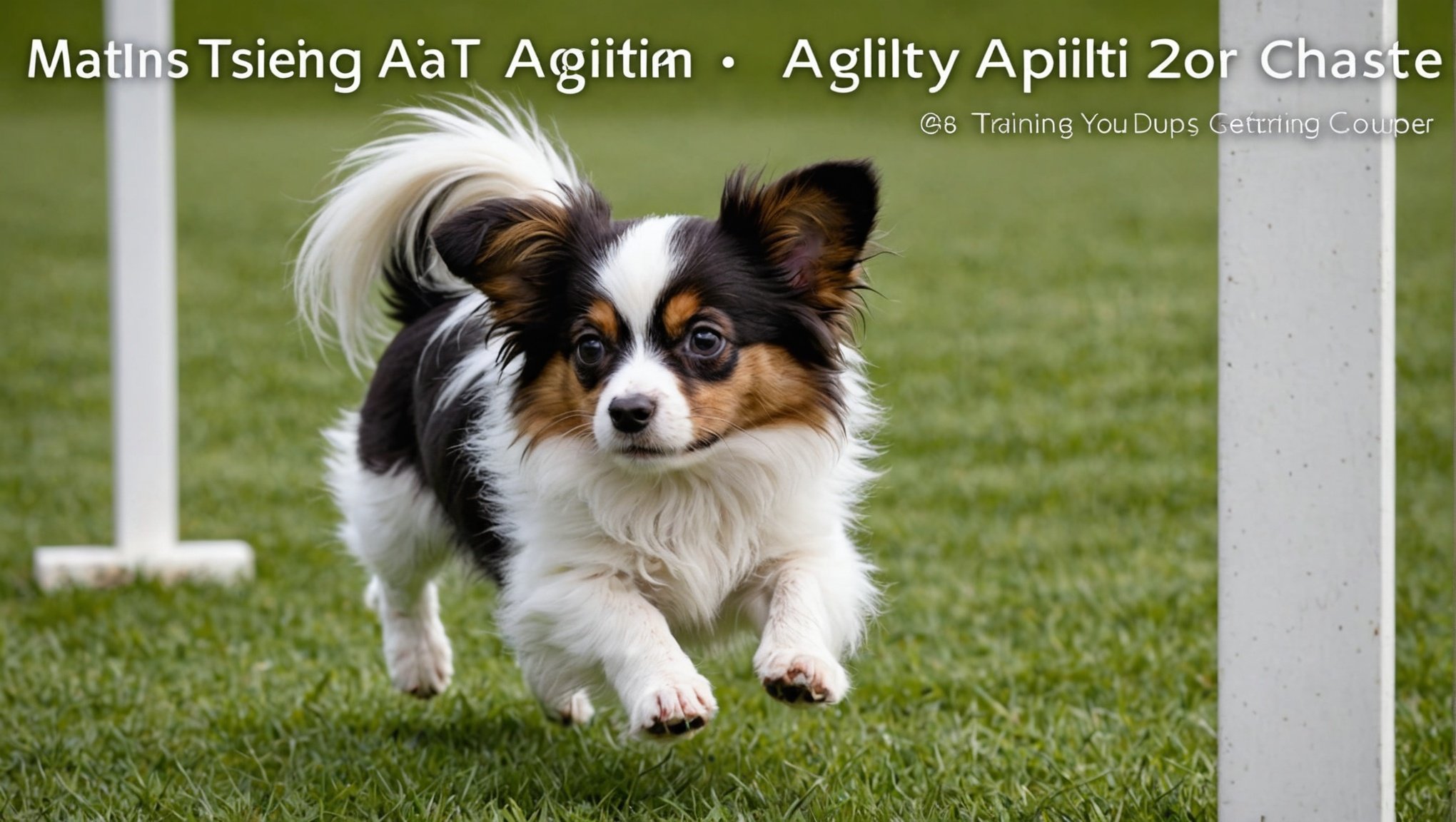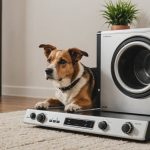Mastering Agility: A Step-by-Step Guide to Training Your Papillon Puppy on an Exciting Dog Agility Course
Understanding the Basics of Dog Agility
Dog agility is a thrilling dog sport that combines physical exercise, mental stimulation, and fun for both you and your puppy. It involves navigating through a series of obstacles, such as tunnels, jumps, weave poles, and contact zones, which require coordination, balance, and teamwork between you and your dog.
When starting agility training with your Papillon puppy, it’s crucial to understand that this sport is not just about speed and agility but also about building a strong bond and ensuring your dog’s safety and well-being. As Arlene Spooner, a Senior Agility Field Representative, advises, “Keep it fun and stop before your dog loses interest”.
Also to discover : Mastering Noise: A Fun Guide to Help Your Dog Adjust to Loud Household Appliances
Preparing Your Puppy for Agility Training
Cognitive Development and Readiness
Before diving into agility training, it’s essential to consider your puppy’s cognitive and physical development. Research from Duke University indicates that puppies develop cognitive skills at different rates. For instance, they can understand basic human gestures like pointing from an early age, but self-control and understanding of the physical world develop later, around 10 to 14 weeks old.
Given this, it’s important to tailor your training sessions to your puppy’s developmental stage. For example, if your puppy is under 10 weeks old, focus more on basic obedience and socialization rather than complex agility tasks.
This might interest you : Mastering the Art of Desensitizing Your Dog to Loud Noises: A Comprehensive Guide
Physical Conditioning and Core Strength
Physical conditioning is vital for any dog engaging in agility sports. The core of your dog, including the abdominals and lower back, plays a critical role in providing efficient front and rear limb work. A strong core helps in running, jumping, and turning, reducing the risk of injury.
To build your puppy’s core strength, you can start with simple exercises like having them sit on a sturdy box or bin, or encouraging them to place their paws on an elevated surface. These activities help improve balance and flexibility.
Setting Up Your Home Agility Course
Essential Equipment and Safety Considerations
You don’t need a large backyard or expensive equipment to start agility training at home. Here are some essential items to get you started:
- Tunnels: You can use cardboard boxes or PVC pipes to create tunnels.
- Jumps: Start with low jumps using broomsticks and books or flower pots.
- Weave Poles: Use PVC pipes or even broomsticks stuck into the ground.
- Contact Zones: A sturdy box or bin can serve as a pause table.
- Ladders: Lay a ladder flat on the ground for your dog to practice stepping through the rungs.
Remember to practice on non-slippery surfaces and ensure that any equipment can fall without harming your dog if accidentally hit.
Step-by-Step Guide to Setting Up Obstacles
Here’s a detailed list to help you set up a basic agility course at home:
-
Tunnel Training:
-
Start with short tunnels made from cardboard boxes.
-
Encourage your puppy to enter and exit the tunnel using treats and praise.
-
Gradually increase the length and complexity of the tunnels.
-
Jump Training:
-
Begin with low jumps (about walking height for growing puppies).
-
Use a broomstick balanced between two low objects.
-
Increase the height gradually as your puppy becomes more confident.
-
Weave Pole Training:
-
Start with two poles and gradually add more.
-
Use treats to lure your puppy through the poles.
-
Practice weaving in both directions.
-
Contact Zone Training:
-
Use a sturdy box or bin as a pause table.
-
Encourage your puppy to jump onto the box and sit or lie down.
-
Gradually increase the height and duration of the pause.
-
Ladder Training:
-
Lay a ladder flat on the ground.
-
Use treats to entice your puppy to step through the rungs.
-
Increase the speed and complexity as your puppy becomes more comfortable.
Developing Key Skills for Agility
Tricks and Body Awareness
Teaching your puppy specific tricks can significantly enhance their agility performance. Here are a few tricks that are particularly beneficial:
- Nose Targeting: Teach your puppy to touch their nose to your hand or a target. This helps with positioning and entering contact zones.
- Back-Up: This trick improves body awareness as your puppy must pay attention to all four paws.
- Spin: This trick stretches your puppy’s sides and improves flexibility.
- Bow: This trick stretches your puppy’s back and is a great warm-up exercise.
- Figure Eight: Weaving a figure eight around your legs helps with flexibility and introduces the concept of weaving through poles.
Flexibility and Coordination Exercises
Flexibility is crucial for agility dogs, especially when navigating tight turns and complex obstacles. Here are some exercises to improve your puppy’s flexibility:
- Spin: Use your hand or a target to lead your puppy in a circle, stretching their sides.
- Bow: Encourage your puppy to stretch their back by touching their paws to the ground while keeping their rear end in the air.
- Weave Through Legs: Have your puppy weave a figure eight around your legs, which helps with tight turns and flexibility.
Training Sessions and Positive Reinforcement
Structuring Your Training Sessions
When training your puppy, it’s important to keep the sessions short and fun. Here are some tips for structuring your training sessions:
- Duration: Keep sessions between 5 to 10 minutes to avoid overwhelming your puppy.
- Frequency: Practice several times a week, allowing your puppy time to rest and recover.
- Positive Reinforcement: Use plenty of praise, treats, and affection to reinforce good behavior.
The Role of Positive Reinforcement
Positive reinforcement is a cornerstone of effective dog training. Here’s why it’s so important:
- Encourages Good Behavior: Positive reinforcement encourages your puppy to repeat desired behaviors.
- Builds Trust: It strengthens the bond between you and your puppy.
- Reduces Stress: Positive reinforcement makes training sessions enjoyable and stress-free.
As Arlene Spooner emphasizes, “Keep it fun and stop before your dog loses interest”.
Common Challenges and Solutions
Overcoming Fear and Lack of Confidence
Some puppies may initially be fearful or lack confidence when encountering new obstacles. Here are some tips to overcome these challenges:
- Gradual Exposure: Introduce obstacles gradually, starting with simple and low-height challenges.
- Positive Reinforcement: Use treats and praise to encourage your puppy to overcome their fears.
- Patient Approach: Be patient and do not rush your puppy. Let them set the pace and build confidence at their own speed.
Managing Injuries and Health Issues
Agility training, like any physical activity, carries the risk of injury. Here are some tips to manage injuries and health issues:
- Consult a Veterinarian: Before starting any new exercise program, consult with your veterinarian to ensure your puppy is healthy enough for agility training.
- Warm-Up and Cool-Down: Always include a warm-up and cool-down session to prevent injuries.
- Canine Rehabilitation: If your puppy does get injured, consider consulting a canine rehabilitation specialist to ensure proper recovery and prevent future injuries.
Preparing for Agility Competitions
Understanding Agility Competitions
If you and your puppy enjoy agility training, you might consider participating in agility competitions. Here’s what you need to know:
- AKC Competitions: The American Kennel Club (AKC) hosts various agility competitions. These events are a great way to test your puppy’s skills and bond with other dog owners.
- Course Layout: Agility courses vary but typically include a mix of tunnels, jumps, weave poles, and contact zones.
- Judging Criteria: Dogs are judged on their speed, accuracy, and teamwork with their handler.
Tips for Success in Agility Competitions
Here are some tips to help you and your puppy succeed in agility competitions:
- Practice Consistently: Regular practice helps build your puppy’s skills and your teamwork.
- Focus on Fun: Remember that agility is a sport meant to be enjoyed by both you and your dog. Keep the atmosphere positive and fun.
- Stay Calm and Focused: During competitions, stay calm and focused. This helps your puppy remain calm and perform at their best.
Training your Papillon puppy for dog agility is a rewarding and fun experience that strengthens your bond and provides your dog with physical and mental stimulation. By understanding the basics of agility, preparing your puppy appropriately, and using positive reinforcement, you can set your dog up for success in this exciting sport.
Remember, every puppy is unique, and patience and adaptability are key. Whether you’re aiming for agility competitions or just enjoying the sport for fun, the journey of mastering agility with your puppy is an enriching experience for both of you.
Practical Insights and Actionable Advice
- Start Small: Begin with simple obstacles and gradually increase the complexity.
- Keep it Fun: Ensure that training sessions are enjoyable and engaging for your puppy.
- Consult Professionals: If you encounter any challenges or health issues, consult with veterinarians or canine rehabilitation specialists.
- Be Patient: Agility training is a process that requires patience and consistency.
By following these guidelines and tips, you can help your Papillon puppy become an agile and confident dog, ready to take on any agility course with enthusiasm and skill.










